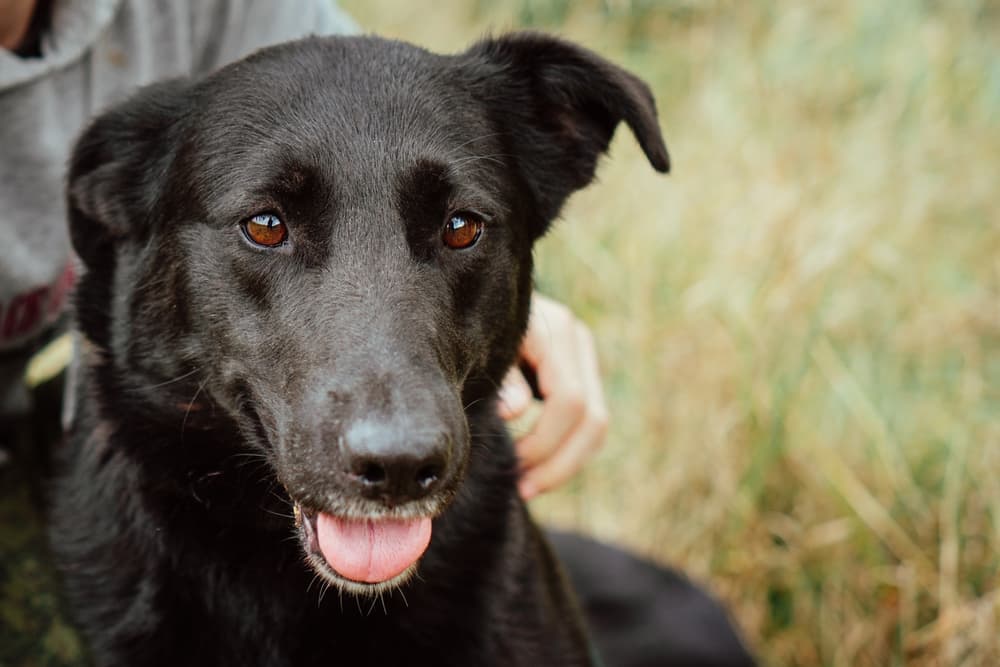While this cute behavior is completely harmless, if you see your dog walking in circles, trying to bite his tail, or circling and unable to settle it might be cause for concern.
Our dogs still exhibit the same behavior today although instead of grass they’re settling into it is a nice cozy spot on the bed. Your dog may have a nap time or bedtime routine where he scratches at his bedding, does a few circles and then settles down for the night.
There are several more serious reasons your pet might walk in circles. If you see your dog walking in circles, unable to stop or is crashing into walls or getting stuck in corners you may want to take him to see the vet for a checkup to rule out the following other conditions.
There are several theories as to why dogs do this. Some say it is a hereditary behavior from before dogs were domesticated. Dogs used to settle in for the night outdoors in the grass or dirt and the circling would push the grass or dirt down to make it more comfortable or even scratch at it to make it soft so they could get a good night’s rest.
Does your pup make a few circles before settling down on his bed, your bed or his favorite spot on the couch? Do you think this is the cutest thing you’ve ever seen? Have you ever wondered why he does this?
Ways to Determine What the Problem Could Be
 You can try a few things to help you figure out what could be causing your dog to walk in circles. If your dog is spinning in one direction, see if you can get them to move in the opposite direction or to walk normally. If there is a neurological issue, the dog will not be able to change direction easily. Moreover, a neurological issue can also affect your dog’s ability to focus its eyes, making them seem blind in one or both eyes. Also, inspect your dog’s ears. Do you see any signs redness that could indicate an ear infection? Whatever the case, doing it yourself should never take the place of a professional evaluation by a veterinarian. Walking in circles can be a serious issue that may require immediate treatment.
You can try a few things to help you figure out what could be causing your dog to walk in circles. If your dog is spinning in one direction, see if you can get them to move in the opposite direction or to walk normally. If there is a neurological issue, the dog will not be able to change direction easily. Moreover, a neurological issue can also affect your dog’s ability to focus its eyes, making them seem blind in one or both eyes. Also, inspect your dog’s ears. Do you see any signs redness that could indicate an ear infection? Whatever the case, doing it yourself should never take the place of a professional evaluation by a veterinarian. Walking in circles can be a serious issue that may require immediate treatment.
You can reduce the odds of your dog suffering from many of the aforementioned conditions by taking a few simple steps:
Ear Hygiene: The best way to prevent an ear infection is regular cleaning. Make cleaning your dog’s ears part of your dog’s regular hygiene regimen. This will go a long way toward preventing an ear infection due to wax buildup, ear mites, or injury.
Annual Vet Checkups: Stay on top of your dog’s health by keeping up with annual vet wellness checkups. During the annual wellness checkup, the vet will examine the dog’s vital signs, palpate the entire body for pain or lumps, and check the dog’s weight, skin, vision, and hearing. It will also include vaccinations to prevent deadly diseases, and if necessary, perform blood work to diagnose a developing health condition.
Know Your Dog Well: Most dog parents love their dogs and know what constitutes “normal behavior.” They also likely keep a close watch on their dogs when they are at the dog park or interacting with other dogs or people, as well as what environmental triggers (food, people, other dogs, etc.) their dog responds to. Monitoring their dog like this helps minimize their risk of injury by ensuring that you can discern between normal and irregular behavior. When an injury does occur, dog parents who know their dog will see it happen quickly and can take swift action to give it appropriate treatment.
Medical Reasons for Dogs Walking in Circles

A dog walking in circles can sometimes indicate an underlying medical or behavioral issue, so it’s essential to contact your veterinarian if something seems out of the ordinary.
When an illness is responsible for a dog walking in circles, “there are usually other dispositional signs that a dog is unwell,” says Burghardt. Depending on the underlying conditions, other signs may include:
The following are some medical reasons why dogs walk in circles.

If a dog walks in circles and is disoriented or displays other signs like nausea, vomiting, and weakness, an inner ear condition like vestibular disease may be responsible. Middle ear and inner ear conditions like vestibular disease are frequent culprits, says Burghardt, “especially in ear infection-prone dogs and older patients.” Vestibular disease, which is a condition that affects a dog’s balance and is often confused for a stroke, can be peripheral or central, and is called ‘old dog vestibular disease.’ This condition, while dramatic, requires supporting the dog, and often resolves spontaneously over time.

Dogs unable to find healthy outlets for their fear and anxiety might instead rely on a number of displacement behaviors, one of which is circling or spinning, says Burghardt.
Some breeds, like Bull Terriers and German Shepherds are thought to be more genetically predisposed to developing canine compulsive disorders. “Terriers, especially Bull Terriers may be more likely to display a behavioral problem with spinning or tail-chasing,” explains Burghardt. “This type of behavior, called compulsive behavior, needs to be fully evaluated and usually needs behavioral, medical, and environmental treatment to help control.”

Trauma, tumors, and infections are examples of neurological conditions that might cause a dog to walk in circles, says Lilly. “Any neurological disease could cause circling, whether that’s in the front of the brain, or if there is a spinal cord problem causing weakness in one side of the body. The dog may naturally drift in very loose circles toward the weak side when not directly attending to things on the opposite side of its body.”
Central vestibular disease can be caused by antibiotics, including amikacin, gentamicin, neomycin, and tobramycin, as well as hypothyroidism, head trauma, tumors, and infections.

Anal gland disease flea allergy dermatitis, and lower spinal pain, for example can cause a dog to circle tightly, “Or attempting to lick, chew, or bite at the tail or rump,” says Lilly.
Circling in pet dog, reasons, treatment options/ vestibular syndrome /old dog disease/imbalance dog
 Your dog’s behavior is a good clue as to what is going on inside his or her body. Walking in circles is actually a normal behavior for many dogs just before they urinate, defecate, or lie down. Other than in those instances, frequently walking in circles, or slowly or quickly spinning, is often a sign that the dog has an underlying health issue. If you observe your dog walking in circles, don’t ignore it. Your dog should be examined by a professional veterinarian as a precaution because circle walking could be a sign of a serious health problem.
Your dog’s behavior is a good clue as to what is going on inside his or her body. Walking in circles is actually a normal behavior for many dogs just before they urinate, defecate, or lie down. Other than in those instances, frequently walking in circles, or slowly or quickly spinning, is often a sign that the dog has an underlying health issue. If you observe your dog walking in circles, don’t ignore it. Your dog should be examined by a professional veterinarian as a precaution because circle walking could be a sign of a serious health problem.
Ear Infection: An ear infection is one of the most common reasons why dogs walk in circles. An ear infection usually has one or more additional symptoms, such as offensive smells coming from the ear, redness, head shaking, and scratching at the ear. An ear infection must be treated quickly by a vet, as infections can move deeper into the dog’s ear and cause more serious problems. Treatment for ear infections involve a deep ear cleaning that must be done by the vet to avoid damaging the dog’s inner ear, and prescription medications including antibiotics.
While ear infections are by far the most common, your dog may have an infection somewhere else in the body that is causing discomfort or interfering with their balance. Again, it’s important to work with a professional vet who can examine and determine the issue without causing more harm to your dog.
Vestibular Syndrome: This is a disease that is most common in older dogs. Vestibular syndrome affects the dog’s inner ear and balance. What causes the disease is unknown, but animal health experts believe it can result from a variety of factors such as ear damage due to an injury, nutritional deficiency, infection, or abnormal tissue growth. Dogs needs to be examined by a vet to diagnose vestibular syndrome. Other symptoms include frequently falling down, excessive drooling, walking with the head down, and circling.
Neurological Disease or Bodily Injury: A disease or injury that affects your dog’s neurological system can also likely cause your dog to walk in circles. Common diseases that can cause incoordination include:
Alternatively, a head, back, or neck injury that impacts the neurological system can also cause incoordination, as well as pupil dilation, whining, or loss of appetite. If you spot any of these symptoms, get your dog to the nearest vet right away for a comprehensive diagnosis and immediate treatment.